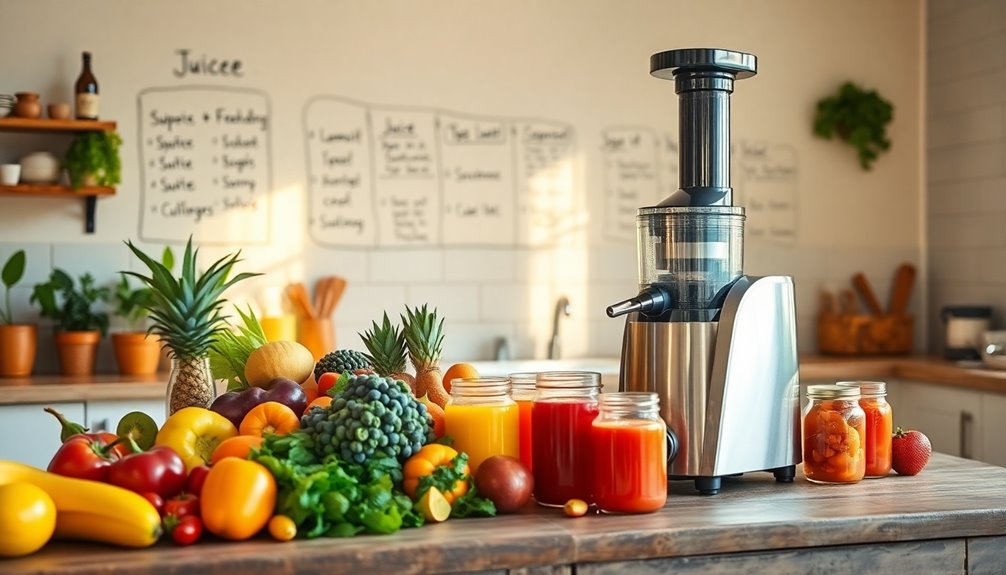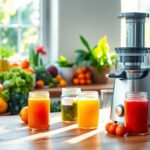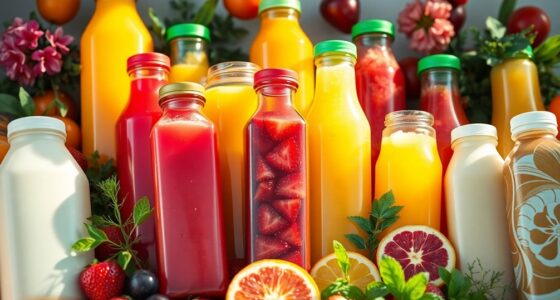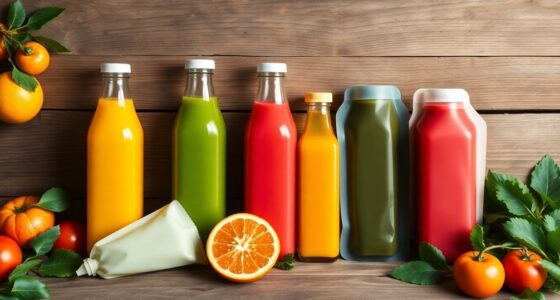To boost your juicing on a budget, invest in a reliable juicer and simplify recipes using seasonal produce. Explore local buying options like farmers markets and co-ops for fresh ingredients. Buying in bulk can save you money while preventing waste by utilizing every part of the produce. Adjust your juicing frequency to fit your budget, and consider incorporating whole foods into your meals. There's much more you can discover to make juicing both fun and affordable.
Key Takeaways
- Invest in a reliable slow juicer to maximize juice extraction and nutrient retention while minimizing waste and costs.
- Buy seasonal produce in bulk from local farmers or markets to enhance flavor and reduce expenses.
- Utilize every part of the produce, incorporating scraps into meals or freezing overripe fruits for future use.
- Adjust your juicing frequency to three days a week while focusing on whole foods for balanced nutrition.
- Regularly assess your budget and explore cost-effective produce options to align juicing habits with financial goals.
Invest in a Reliable Juicer

When it comes to juice production, investing in a reliable juicer can make all the difference. A high-quality slow juicer, like the Fretta Edge Max, guarantees you extract maximum juice from your produce while retaining essential nutrients. This not only enhances the flavor but also provides significant health benefits.
By reducing heat and oxidation, cold-pressed juicers maintain the integrity of vitamins and enzymes, promoting your overall well-being. Additionally, a dependable juicer allows you to maximize your yields, ultimately helping to reduce waste and save money in the long run. Regularly incorporating juices like beet juice can further support your health due to its impressive benefits, including improved blood flow and stamina.
If you're on a budget, consider refurbished or second-hand juicers from sites like Craigslist or eBay. This way, you can enjoy a quality juicing experience without breaking the bank.
Simplify Recipes With Seasonal Produce
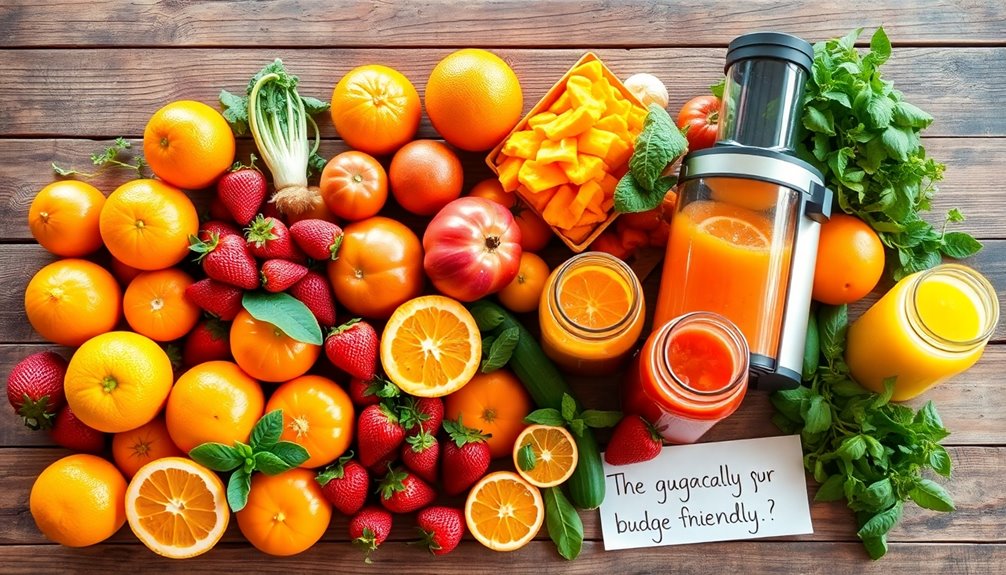
By embracing seasonal produce, you can simplify your juice recipes while enhancing both flavor and cost-effectiveness. Using fruits and vegetables that are in season not only boosts freshness but also helps reduce costs since they're more abundant and often priced lower.
Incorporating high-water content seasonal fruits like watermelon and cucumbers can increase your juice yield, making them perfect for budget-friendly juicing recipes. Planning your juices around what's in season encourages creativity and minimizes reliance on expensive out-of-season produce.
Plus, buying seasonal produce in bulk from local farmers can lead to significant savings while supporting community agriculture. Utilizing a Juice Crew Template Recipe can also streamline the process, ensuring you reduce food waste and maximize ingredient availability throughout the year. Additionally, seasonal fruits often provide more vitamins and minerals than out-of-season options, further enhancing the nutritional value of your juices.
Explore Local Buying Options
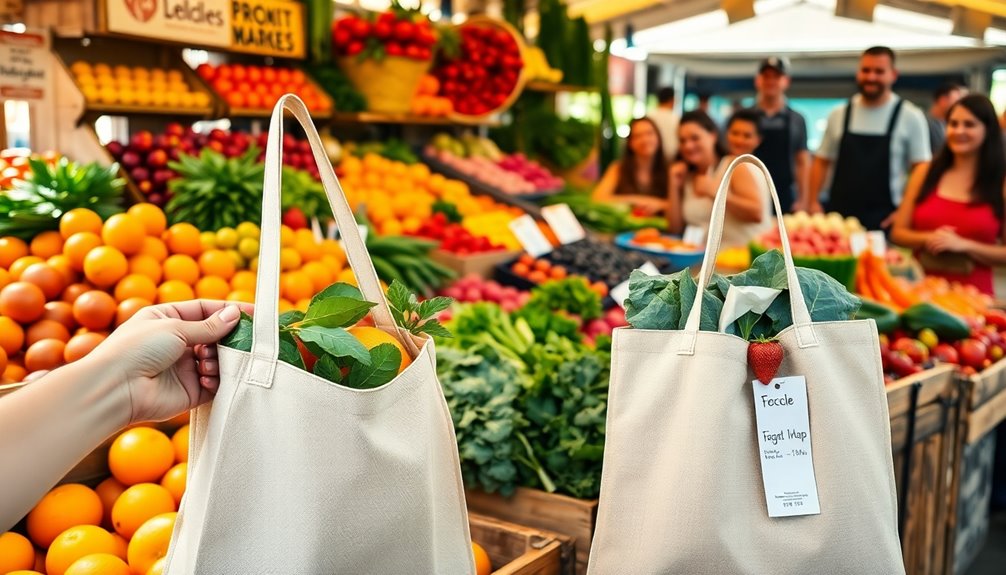
How can you make your juicing more affordable and sustainable? Start by exploring local buying options like farmers markets. They often offer fresh, seasonal produce at lower prices than conventional grocery stores, helping you save on juicing ingredients.
Building relationships with local farmers can also lead to consistent supply and potential discounts, as many are open to negotiating prices for regular customers. Consider joining a community-supported agriculture (CSA) program for access to a variety of organic produce at reasonable costs. Additionally, local co-ops often provide great deals on fresh ingredients and support sustainable farming practices.
Not only will you enjoy better quality and taste, but you'll also support the local economy and reduce your carbon footprint. By choosing to buy your produce locally, you're making a positive impact while keeping your juicing budget-friendly.
Buy in Bulk for Cost Savings

Buying in bulk can greatly cut your juicing costs, making it a smart choice for anyone looking to save money. When you purchase fruits and vegetables in larger quantities, you often benefit from lower prices per pound, especially at membership clubs like Costco or Sam's Club.
This approach guarantees you have a steady supply of essential ingredients, helping maintain your juicing routine while reducing shopping trips. Plus, buying seasonal produce in bulk lets you enjoy fresher options at a lower price.
- Save money by reducing the price per pound
- Guarantee a steady supply of juicing ingredients
- Minimize food waste by using every part
- Enjoy fresher, flavorful produce all year round
- Additionally, leveraging bulk purchasing allows you to experiment with new recipes without worrying about high costs.
Engage With the Community for Support
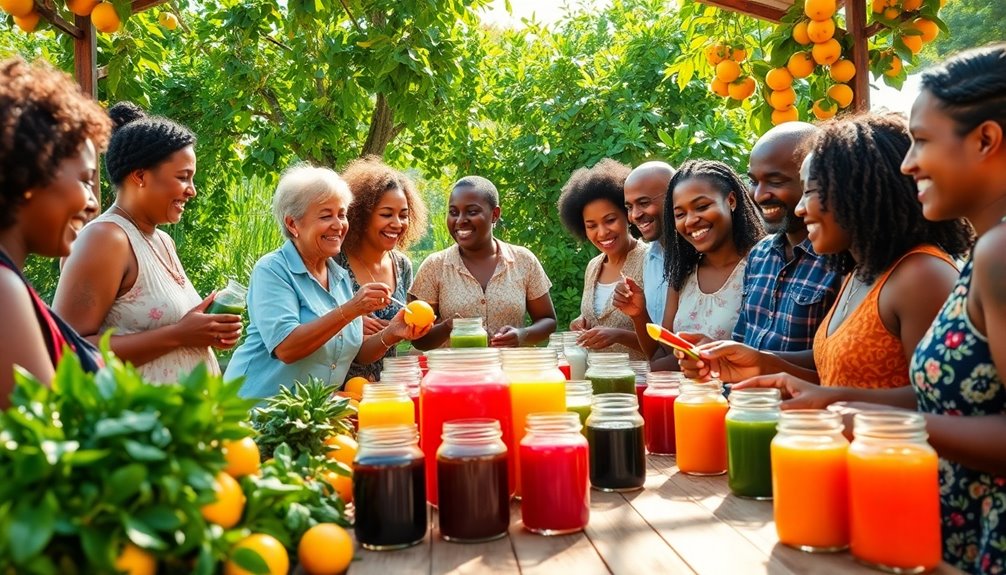
While diving into the world of juicing, engaging with your community can provide invaluable support and resources. Participating in local co-ops or visiting farmers markets not only helps you find affordable, organic produce but also builds relationships with local farmers. This can lead to discounts and special offers on your favorite fruits and veggies. Additionally, local foraging groups can offer seasonal foraging tips and resources for finding wild edibles that can enhance your juice recipes.
| Community Engagement | Benefits |
|---|---|
| Local Co-ops | Access to cheaper, organic produce |
| Farmers Markets | Direct communication with growers |
| Online Forums | Budget-friendly tips and community support |
Utilize Every Part of the Produce

You can save money and enhance your nutrient intake by utilizing every part of the produce you buy. Instead of tossing out stems and pulp, think about how you can incorporate them into meals or drinks, cutting down on waste. For example, consider adding chia seeds to smoothies or salads to boost their nutritional value and reduce food waste.
Save Money on Ingredients
Maximizing savings in juice production starts with utilizing every part of the produce you buy.
This approach not only helps you stay on budget but also enhances your juicing experience.
Here are some creative ways to save money on ingredients:
- Blend carrot tops into pesto or salads.
- Use juice pulp in smoothies, soups, or baked goods.
- Incorporate vegetable scraps like onion peels into homemade broth.
- Freeze overripe fruits for added sweetness in juices.
Additionally, consider using fresh herbs like mint or basil to elevate your juice flavors without significant additional costs.
Reduce Waste Effectively
Finding ways to save money on ingredients naturally leads to a focus on reducing waste. You can make the most out of your juicing by utilizing leftover pulp in smoothies, soups, or baked goods. This not only reduces waste but also contributes fiber to your diet.
Save scraps like peels and stems to create homemade vegetable broth or add them to your compost. Freeze any excess juice in ice cube trays; these can later enhance smoothies or flavor water and teas.
Consider dehydrating leftover pulp to make healthy snacks or crackers. You might even forage for edible plant parts, such as beet greens or carrot tops, to incorporate into your juices—supporting local agriculture while maximizing every bit of produce. Additionally, incorporating vegetable juices can provide a nutrient-rich base for your creations, further utilizing all parts of the produce.
Enhance Nutrient Intake
- Use leftover pulp in smoothies, soups, or baked goods.
- Incorporate vegetable scraps like carrot tops and beet greens into your juice recipes.
- Blend whole fruits and veggies, including safe peels, for extra vitamins.
- Infuse water with citrus peels or herb stems for a revitalizing drink.
Additionally, consider incorporating cacao's health benefits into your juices for an extra boost of antioxidants and mood enhancement.
When you make juice with these techniques and an inexpensive juicer, you'll enjoy delicious flavors while reducing waste.
Embrace every part of your produce, and watch your nutrient intake soar!
Adjust Juicing Frequency to Fit Your Budget

If you're looking to save money, consider reducing your juicing days from five to three each week. On non-juicing days, you can incorporate whole, raw food meals to keep your nutrition on track without breaking the bank. Mixing in fruit salads or raw desserts can also add variety while focusing on fresh produce. Additionally, including foods rich in folate can further support your nutritional needs during this time.
Reduce Juicing Days
Adjusting your juicing frequency can be a smart way to manage your budget while still enjoying the health benefits of nutrient-rich juices. By reducing juicing days from five to three, you can lower produce costs and still meet your health goals.
Here are some tips for juicing:
- Incorporate whole, raw meals to maintain nutrition.
- Experiment with fruit salads or raw desserts to replace some juicing sessions.
- Reassess your budget regularly to align juicing habits with financial goals.
- Focus on a diverse diet; even occasional juices can enhance nutrient intake.
With these strategies, you can enjoy fresh produce without the expense of daily juicing, making it easier to stick to your budget while reaping the benefits of healthy juices.
Incorporate Whole Foods
Incorporating whole foods into your diet can considerably enhance your nutrition while keeping costs down. Instead of relying solely on fresh juice, consider adjusting your juicing frequency to three times a week.
This way, you can buy a variety of whole foods at grocery stores, ensuring you still get essential nutrients without overspending. Experimenting with fruit salads or raw desserts can provide similar health benefits while adding excitement to your meals.
By focusing on whole foods, you can enjoy a balanced diet that promotes overall wellness. Periodically reassess your budget to make sure your juicing habits align with your financial capabilities.
This approach allows for variety and sustains your health goals without breaking the bank.
Frequently Asked Questions
What Is the 80 20 Rule for Juicing?
The 80/20 rule for juicing means you should aim for 80% of your juice to come from high-water content fruits and veggies, like cucumbers and oranges.
The remaining 20% can be nutrient-dense greens or herbs to boost flavor and health benefits.
By following this guideline, you'll maximize juice yield, keep costs down, and simplify your shopping list while allowing for variety and experimentation in your diet.
Enjoy your juicing journey!
What Is the Cheapest Juice to Make?
If you're looking for the cheapest juice to make, carrot apple ginger juice often tops the list, costing around $1.50 per serving.
You can reduce costs further by using bulk carrots and seasonal apples.
Another budget-friendly option is cucumber spinach lemon juice, averaging just $1.20 per serving.
How to Juice Fast on a Budget?
Juicing on a budget's like crafting a masterpiece from scraps; it takes creativity and resourcefulness.
Start by buying seasonal, local produce, which is fresher and cheaper. Maximize your yield with high-water fruits like cucumbers and melons.
Don't forget to plan your recipes to avoid overspending and waste. Consider bulk buying at membership stores too.
Finally, use leftover pulp in smoothies or soups to stretch your budget even further.
How Can I Make My Juice Business Successful?
To make your juice business successful, focus on creating a personalized experience for your customers.
Implement an app for custom juice blends and exclusive offers. Establish a loyalty program to reward repeat visits, enhancing customer retention.
Host wellness events to engage the community and boost visibility. Utilize social media for interactive campaigns, and source organic, local ingredients to attract health-conscious consumers.
These strategies can greatly drive your revenue and position your brand as a leader.
Conclusion
By implementing these budget-friendly techniques, you’ll transform your juice production into a thriving venture. Think of your juicing journey like tending to a garden; the more you nurture it with smart choices, the richer the harvest. Just as a gardener learns to use every inch of soil, you’ll discover ways to maximize your resources. So roll up your sleeves, get creative, and watch your affordable juice production blossom into something remarkable! Embrace the art of experimentation, experimenting with various fruits and vegetables to find the perfect combinations that please the palate without breaking the bank. By focusing on efficiency in juice production methods, you can streamline your processes and reduce waste, ensuring that every drop counts. With a little patience and persistence, you’ll not only create delicious juices but also build a sustainable operation that attracts customers eager for quality and affordability.
Cindy thoroughly researches juicing trends, techniques, and recipes to provide readers with practical advice and inspiration. Her writing style is accessible, engaging, and designed to make complex concepts easy to understand. Cindy’s dedication to promoting the advantages of juicing shines through her work, empowering readers to make positive changes in their lives through the simple act of juicing.

